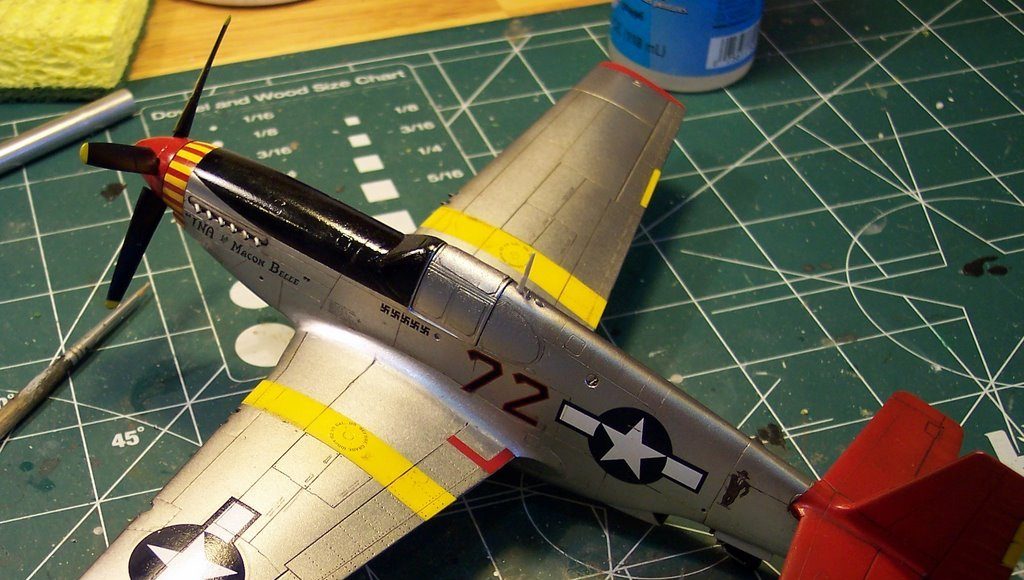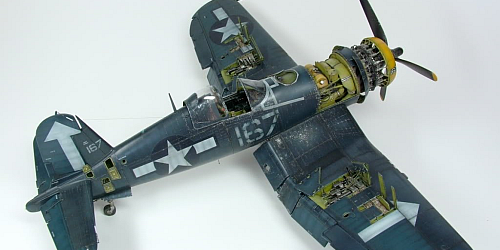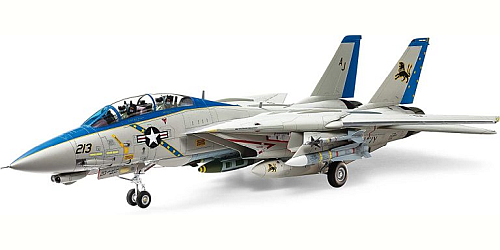Building and detailing plastic model airplane kits – How to Add Extra Details to Your Model Aircraft
Guide to Realistic Tires and Struts
Here are a few simple tricks to make your tires and landing struts look more realistic. These parts are quite small and intricate. So, adding some depth will make them stand out.
- I recommend that all strut parts and wheels be
airbrushed or can be sprayed if possible. This will give a flat, even coat and will give the appearance of smooth metal. Hand brushing will give an uneven, textured surface that will be noticeable. Any enamel or lacquer aluminum paint will do. - If the tires have recessed treads, use a scribing tool or Xacto to clean and deepen the treads some. You will want the treads to hold a wash later. Paint the tires with a standard flat black. They can either be hand or airbrushed.
- Once everything is dry, apply a dark wash to all recessed and raised detail of the struts and wheels. This may take a couple of tries to get the wash to show up. Let dry.
- Use a damp Q-tip to remove the wash where it’s not wanted. A clean, damp pointed brush will also remove the wash in harder to reach areas.
- Any additional detail can easily be enhanced with
dry-brushing and washes. - For a muddy/dirty effect on the tire, apply a liberal amount of wash to the treads. I use a yellow ochre/burnt umber mixture which will contrast with the black tire. When wet, the wash will not show. As it dries, the pigment will lighten and appear as mud trapped in the treads. Several applications may be necessary for visible results.
- Weathering powders can be randomly brushed on the sidewalls for additional contrast as well.
Creating Muddy Tires
In most cases, aircraft used dirt landing strips. Due to the elements, these runways became muddy and sloppy. As the photo shows, the aircraft often had to taxi through the mess. Here is a method to simulate clumped mud on tires. This process can be used for any application that requires this effect. Here is a small list of the items needed. I found them all at Hobby Lobby.
- A small mixing bowl
2. A small, stubby brush
3. A few drops of water-based scenic cement
4. A pinch of fine, dark brown model railroad ballast
5. 2 shades of earth tone dry pastels
6. Xacto knife
How to mix and apply:
- Shave the pastels into a fine powder with the Xacto.
- Add a pinch of the ballast to the pastels.
- Add a few drops of the cement to the pastels. If you add too much, the mix will be too runny. If this happens, just add some pastel to thicken.
- Mix the ingredients with the brush into a thick slurry.
- Using the brush, apply the mix to the tire and sidewalls. Place a thick coat all the way around the tire except where the tire sits on the surface. Leave this area uncovered.
- Allow to fully dry. The cement will dry flat which will give a dried mud effect.
This mix can be applied to other details as well. This includes tailwheels, landing struts, drop tanks, etc. Be creative!
Decal Alternatives
When done correctly, decals can appear to be ‘painted’ on. However, if you choose to actually paint the insignia, numbers or nose art, there are a couple of ways to do it. It will take a little patience and forethought, but the outcome will be worth it.
Make Your Own Stencil/Mask
This may seem a little intimidating at first thought but overall, it’s rather simple. Here’s what you will need:
- A piece of glass ( I use one from a picture frame)
- A NEW Xacto blade
- A piece of wax paper
- A piece of 1″ wide low tack masking tape. 1″ wide should be a sufficient size for most 1:48 work. If a larger piece is needed,
double it up or go to a wider size. - A sharp pencil
- A ruler
- A little artistic ability
For this tutorial, I will be making a nose art mask for a “Burma Banshees” P-40N. A skull goes on either side of the nose. Since the skulls will be white over the Olive Drab scheme, I will use a mask as opposed to a stencil. If the skulls were to be a darker color, then I could use a stencil. White will not coat well over Olive Drab (or any other darker color) without excessive coats.
Here are the basic steps:
- Determine the dimensions of the nose art according to your model’s scale. Measure the area on the actual model where the mask will be placed. For example, I have a 1″ by 1″ box on the P-40 nose to work with.
- An actual picture of the image will help to recreate it. I found a great shot on the internet to use as a guide. This will help with relative sizing and placement.
- Place the tape on the glass and mark off the image dimensions on the tape. Then, draw the image on the tape with a pencil. It may take several attempts but that’s what the eraser is for.
- Once drawn, lift the tape off the glass and stick on the piece of wax paper. If a second image is needed for the other side of the nose, apply another piece of tape on the backside of the wax paper.
- Place your work on the glass or a cutting mat and carefully cut the image out with the Xacto knife. Be sure to apply enough pressure to cut all the way through. Now, you have both a stencil and mask.
- If you flip the cut image over, you now have a second mask for the other side which is identical. The wax paper is now sandwiched between the two images. Be sure to trim up the edges of the mask so there are clean.
- After the model has been primed and allowed to dry, apply a coat of white (or other colors needed) on the model where the mask will go.
- Allow the color to dry for 24 hours. Then, place the masks on the areas and lightly burnish down. Keep in mind, the masks will remain on the model until ALL paint is applied, excluding the clear coat.
- Now the final color coat/coats can be applied over the masks and allowed to fully dry.
- Carefully remove the masks with tweezers.
- Any detail can be added by hand painting or using fine tip permanent markers.
Pre-cut Masks/Stencils
Kenny Loup, the owner of Gator’s Paint Masks, makes pre-cut masks and stencils for a wide variety of modeling applications. For this section, I will demonstrate the 1:48 U.S. insignia sheet Kenny offers. Here are a few items you will need:
- Xacto knife
- A piece of frisket film. This can be found at any art store. It’s a clear vinyl sheet with an adhesive backing. It usually comes stuck to a sheet of waxed paper.
- Tweezers
- Gator Mask insignia sheet
Let’s get started:
- Keep in mind to plan ahead. Give some thought to the order of the colors required. The general rule is, begin with white or the lighter color first and finish with the darkest. With a U.S. insignia, the two colors are white and dark sea blue. So, laying down the white is first.
- After the model has been primed and allowed to dry, apply a coat of white to the area where the insignia will be. Let the white dry for 24 hours.
- Cut the insignia from the main sheet and remove the stencil portion. Be sure to save the stencil for later.
- Cut a piece of the frisket film so it will cover the entire mask and lightly burnish the film to the mask.
- Gently remove the film from the mask backing. The actual mask should stick to the film while removing. Take your time so all the parts of the mask come off together as they were.
- Now place the film/mask to the model. Be sure it’s aligned and positioned before you burnish it down. You may not get a second chance if it has to be removed.
- Once the mask is secure, remove the film slowly so the mask won’t come with it. Now it’s ready for painting.
- Apply all the paint coats that are required except for the clear coat. Allow drying for 24 hours.
- Carefully lift a remove the portion of the mask that will not remain white (white portion in photo). Keep the star and bars masks in place.
- Take the stencil portion that was saved and place so it fits around the exposed white portion. I recommend sticking the stencil to a cloth first to ease the tackiness of the adhesive backing. This will make removal easier if need be. Several attempts may be needed to align correctly.
- Apply the second color (dark sea blue) over the white area.
- Gently pry the masks up with a Xacto blade and remove with tweezers.
Guide for Making Antenna Wiring
On most aircraft, there was a wire stretched from the antenna mast to some point on the plane, usually the rudder. There was also a spring attached to keep the tension and some flexibility on the line. From what I understand, the purpose of this line was to boost reception for a plane to plane communications.
Adding this detail can enhance the overall accuracy and look of the model. There are a few ways to create these lines. Some modelers actually stretch sprue using heat. Some use long strands of hair, usually ‘borrowed’ from their wives! However, I find using a thin gauge music wire works very well. It is rigid and will not sag since the actual wire on the aircraft was under tension. This wire can be purchased from Small Parts, Inc. It comes in an 18″ tube with ten pieces. They are inexpensive and will last quite a while.
What’s needed:
- .005 diameter music wire (this will be an accurate sizing for 1:72
and 1:48 scales) - Small, sharp wire cutters
- CA glue and white crafts glue
- Thin gauge speaker wire (single strand)
- A small diameter sewing needle
- A pin vise with a fine drill bit
- A compass (school type used for striking circles)
Let’s get started:
- Keep in mind, this should be one of the LAST steps in completing the model. This detail is delicate and can be accidentally broken off while handling.
- The antenna mast, if there is one, should be installed and allowed to fully dry.
- Accurately measure the length of the wire needed. Use the compass to measure from the mast to the attachment point. Then, cut the wire to this length.
- Before the wire is glued in place, the tension spring will need to be made and slipped onto the wire. Take the single strand of speaker wire and tightly wrap it around the sewing needle. Wrap enough wire to make a spring about 1/8 of an inch long.
- Now, push the wrapped wire together and slip it off the needle.
- Cut the extra wire off each end of the spring.
- Slip the spring onto the antenna wire. It will be glued into place once the antenna wire is set and glued.
- Turn the model either port or starboard side facing up. Place a small drop of CA on the antenna mast and the attachment point.
- Carefully set the wire between the two points and allow the CA to set.
- Slide the spring either to the antenna mast or the attachment point (whatever the particular aircraft calls for) and CA into place.
- Take the white glue and apply a drop to the wire a small distance off the mast and the attachment point. This will create a bead on the line simulating an insulator. Allow it to dry and reapply another drop to enlarge it if needed. Then, the beads can be painted either white or gray.
- Take a nap. Chances are you will be frustrated and your eyes will be sore.
*Since the actual wire on the aircraft was copper, painting the music wire is not necessary. The music wire has an effective metallic appearance and looks accurate unpainted.




